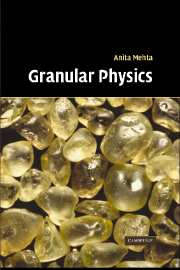Book contents
- Frontmatter
- Contents
- Preface
- 1 Introduction
- 2 Computer simulation approaches – an overview
- 3 Structure of vibrated powders – numerical results
- 4 Collective structures in sand – the phenomenon of bridging
- 5 On angles of repose: bistability and collapse
- 6 Compaction of disordered grains in the jamming limit: sand on random graphs
- 7 Shaking a box of sand I – a simple lattice model
- 8 Shaking a box of sand II – at the jamming limit, when shape matters!
- 9 Avalanches with reorganising grains
- 10 From earthquakes to sandpiles – stick–slip motion
- 11 Coupled continuum equations: the dynamics of sandpile surfaces
- 12 Theory of rapid granular flows
- 13 The thermodynamics of granular materials
- 14 Static properties of granular materials
- References
- Index
- Plate section
7 - Shaking a box of sand I – a simple lattice model
Published online by Cambridge University Press: 06 October 2009
- Frontmatter
- Contents
- Preface
- 1 Introduction
- 2 Computer simulation approaches – an overview
- 3 Structure of vibrated powders – numerical results
- 4 Collective structures in sand – the phenomenon of bridging
- 5 On angles of repose: bistability and collapse
- 6 Compaction of disordered grains in the jamming limit: sand on random graphs
- 7 Shaking a box of sand I – a simple lattice model
- 8 Shaking a box of sand II – at the jamming limit, when shape matters!
- 9 Avalanches with reorganising grains
- 10 From earthquakes to sandpiles – stick–slip motion
- 11 Coupled continuum equations: the dynamics of sandpile surfaces
- 12 Theory of rapid granular flows
- 13 The thermodynamics of granular materials
- 14 Static properties of granular materials
- References
- Index
- Plate section
Summary
Introduction
Vibrating sand results in very varied dynamics, ranging from glassy to fluidised. In much of this book, we will focus on the former, while a subsequent chapter will contain a review of the latter regime. Of course, it is important to have a theoretical understanding of how one regime gives way to the other; it is for this reason that the model discussed in this chapter is a simple model of a vibrated sandbox, which interpolates between the glassy and fluidised regimes through an extremely interesting intermediate regime, whose properties are not fully understood to date, and are the subject of current investigations.
The model is based on the generalisation of an earlier cellular automaton (CA) model of an avalanching sandpile. This version of the model contains only near-neighbour interactions, with grains being in one of two orientational states. It shows both fast and slow dynamics in the appropriate regimes and, in its simplest form, reduces to an exactly solvable model in the frozen or jammed regime. Of course, in order to replicate the truly glassy behaviour of the jammed regime, one needs to introduce true long-range interactions. This will be done in the next chapter, where in particular the effect of grain shapes will be probed using an extension of this model.
- Type
- Chapter
- Information
- Granular Physics , pp. 94 - 103Publisher: Cambridge University PressPrint publication year: 2007



